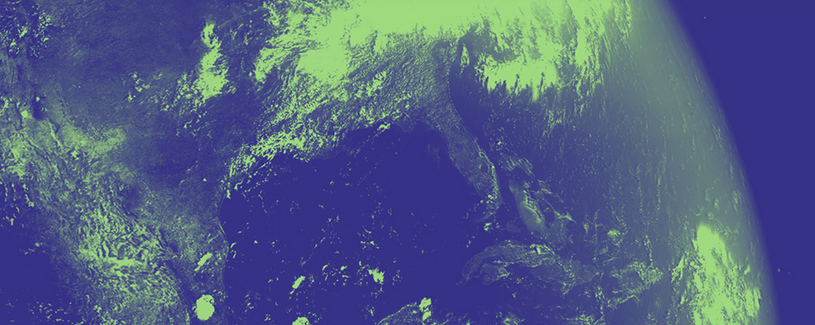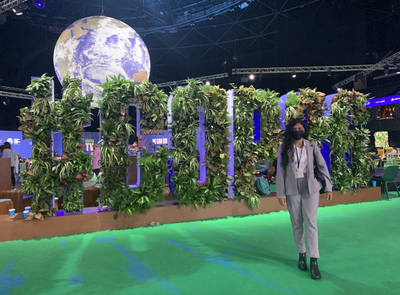COP26 Day 1: Collaborate to Innovate
A collection of reflections from Urvi Talaty, CBEY's Environmental Innovation Fellow

My name is Urvi Talaty and I work as the Environmental Innovation Fellow at Yale. I’m always on the lookout for new models of innovation within existing organizations or emerging startups that are changing the world. During my week at COP26, I wanted to investigate what was happening there with this lens, and see what insight I could bring back to Yale. Between the halls of the official negotiation plenaries and the pavilions of each party, here’s what I found.
Reflections from Day 1
I got off my train from Edinburgh to Glasgow with a sense of excitement, the strong gusts of wind notwithstanding. As I walked towards the Scottish Exhibition Centre where the conference was happening, I was looking forward to learning about new work happening in the innovation space within the larger policy discussions and statements from world leaders.
With the plenary rooms cordoned off today to accommodate the World Leaders Summit and the heads of state in attendance, I decided to visit the Action Zone. As I entered the space, my attention was immediately grabbed by the stunning rotating globe suspended from the ceiling. Unfortunately in my awe as I looked up at the globe, I walked right into another person. After apologising profusely, I found out that I had interrupted a live broadcast. The Action Zone, as I discovered, housed broadcast hubs for several news and media outlets.
The back of my neck stinging after the faux pas, I turned around and noticed two young women wearing green Fridays for Future t-shirts. I went up to them and introduced myself, curious to hear about their work. They were both affiliated with FFF Brazil. When I found out that one of them was considering applying to a masters program, I made sure to give them my card.
Alongside the official negotiations at every COP, organizations and countries from around the world host side events and talks at their pavilions. As I perused the list of events at the Nature+ Pavilion, one immediately caught my eye.
The World Resources Institute’s Land & Carbon Lab was developing a first-of-its-kind monitoring system for the world’s land and its nature-based carbon, according to the event description, and it was being launched today. I knew I had to find out more.
Seats at the pavilion filled up fast, making me glad I showed up fifteen minutes in advance. MCed by Craig Hanson, VP for Food, Forest, Water and the Ocean at the World Resources Institute (WRI), the event brought together scientists from the University of Maryland, project leaders at Google and HSBC and decision makers at the NDC Partnership, African Union Development Agency (AUDA) and WRI.
The Land and Carbon Lab is a new project spearheaded by WRI, building on their previous work with the Global Forest Watch. Their aim is to create a monitoring system that will track land cover, land use and the associated stocks and flows of carbon. The high-resolution spatial data will be made available to the public for free via the Resource Watch and the Global Forest Watch platforms online.
Ani Dasgupta, President and CEO at WRI highlighted in his opening speech that this data will tell us what is happening to land and the associated carbon stocks - to empower everyone to make better decisions.
I was excited because this was a model of innovation that not just valued but prioritized collaboration. As a general narrative, innovation is often associated with notions of competitive advantage and secrecy. And often, innovation is limited to a certain industry or an area of research. But here was an innovative project that brought together the best of each party involved, with the data being shared publicly. Scientific research and technology were being deployed to create better business and policy decisions. That is what excited me the most. Google and the University of Maryland contributed in technology and infrastructure, the AUDA represented an organization that could use the data and monitoring support to successfully work on their AFR100 initiative, and the NDC Partnership could support countries to use accurate data to enhance their Paris Agreement Nationally Determined Contributions.
This innovative project also means that carbon markets can be more accurately designed and that philanthropy organizations funding conservation projects can track better the success of their organizations. But mostly, it empowers communities who are protecting and restoring lands and forests across the world, by giving them the ability to accurately quantify the public benefit they provide. And it means that young people can hold their leaders accountable and startups interested in using the data have one barrier less to overcome. Of course, merely the ability to access data and quantify benefits does not guarantee that there will not be other hurdles to surpass. However, as a first step, maybe it passes muster.
The Land and Carbon Lab is a prime example of why innovation requires partnerships and collaboration across the world. The environment is not a bubble, and it is imperative that organizations learn to work across disciplinary and geographical silos, with decisions being taken having far reaching effects. It also means that collaboration such as this can have far-reaching positive externalities, if managed right. As Crystal Davis, Director of the Global Forest Watch at WRI said in her virtual address - “We need to be collaborating to innovate faster.”
The model, though, also raises several questions. How was WRI planning on training members of civil society to use the data? Were there any negative impacts of this work? How would the sharing of data play out as more partners and countries got involved, anad who would enforce that?
The event ended with WRI calling on more partners - to help translate their data into impact.
Collaboration is key - and we need it everywhere - from working with other countries to tackle the climate crisis to strengthening the innovation ecosystem right here at Yale. And while it may be hard to do that, perhaps we need to follow WRI’s lead and make the first step - and then get others to climb on board. Of course WRI is a prominent NGO in the environmental space, so it might be easier for them to find partners compared to someone just starting out on their innovation journey.
However, so much of what we do here at Yale supports entrepreneurs to find partners and opportunities to collaborate with others. We have seen submissions to grants and prizes represent founders from across school and disciplines. Even more intentionally, intensives at CBEY and Tsai CITY bring together folks from across the university, as do programs like GreenLight and the Planetary Solutions Project. So if you are exploring or working on an idea, I encourage you to look for collaborators in your networks who might help you accelerate the impact that you will have, perhaps by joining an intensive at Tsai CITY or a discussion group at CBEY. If you are looking for resources or mentorship, or have those to offer, I encourage you to come chat with me.
